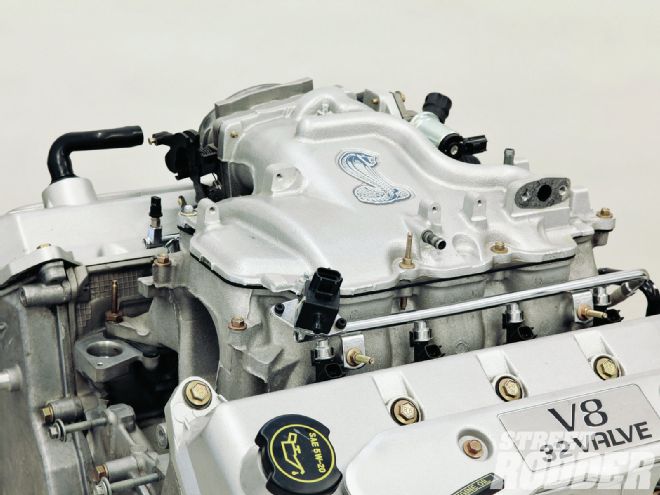
If the phrase old-school modular seems like an oxymoron (much the same way the phrase jumbo shrimp doesnt really make any sense), then let us explain.
When put to the test, just about anyone can recall what the engine of a mid-60s Ford Cobra used for racing looked like. Typically topped with a pair of four-barrel carbs or, even better, a set of four Weber 48 IDA downdraft carbs, the look of the engine was only surpassed by its legendary performance.
The factory 60s-era engines for the street were simple and looked great but, as government regulation and emission controls began to infiltrate the automakers design centers, manufacturers began to cover up their engines and, in doing so, effectively removed the soul of the car. By the 90s it was almost to the point where a guy couldnt modify any of the newer engines for performance or lookswell, almost.
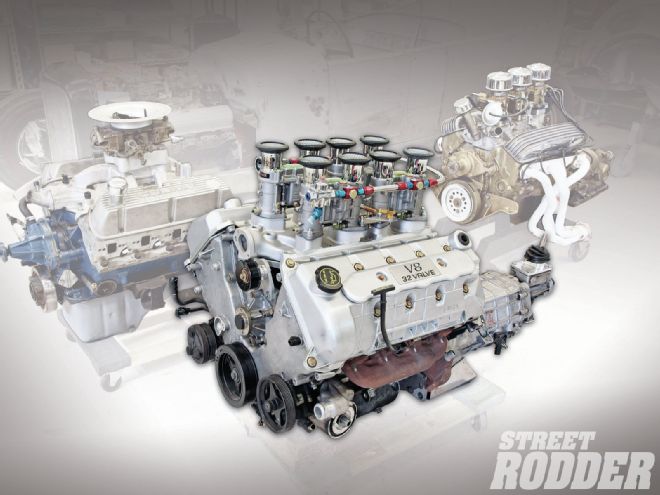 If you want people to do a double take when you open your hood, you might want to try a 4.6L, 32-valve V-8 topped with a set of four Inglese 48 IDA carbs!
If you want people to do a double take when you open your hood, you might want to try a 4.6L, 32-valve V-8 topped with a set of four Inglese 48 IDA carbs!
Jamie Johnson, a 38-year-old second-generation hot rodder, recently showed us a different way to think about one of Fords modular motors. If his name is familiar, then you might remember the copper-colored modified he built a few years back at Hot Rod Haven, his shop based in Albuquerque, New Mexico. Or maybe the maroon 32 three-window with the reverse Halibrands on the cover of our July 09 issue. Or maybe the blue Model A highboy on the June 10 cover. You get the ideaJamies got a good eye.
But hes also recently turned his attention to some of newer powerplants Ford has produced and, in particular, modular motors. Since the early 90s, Ford made several versions of their modular motor (from 281-inch V-8s up to 413-inch V-10s), which also include the popular 302-inch, 5.0L Coyote engines youve recently seen popping up in rodders engine bays.
But, before the 5.0L Coyote, there was the 4.6L 281. It first came in the 91 Lincoln Town Cars in a two-valve per cylinder, single-overhead cam (SOHC) layout but, through the years, a 24-valve variant was also available as was a 32/four-valve design. The 24-valve SOHC was found in some Fords between 2005 and 2010, but its the four-valve engines Jamie was interested in.
The four-valve 4.6-liter is a four-cam, dual-overhead cam (DOHC) design first used in the 93 Lincoln Mark VIII, and most of the motors used an aluminum block with six-bolt mains. Late-90s Lincolns (both the Mark VIII and Continental), the 03-04 Mustang Mach 1, the 03-04 Mercury Marauder, and even the 03-05 Lincoln Aviator all sported this engine.
The early versions of the 4.6 4 V (from 1993 to 1998) utilized two intake ports per cylinder but that design was revised in 1999 so there would be one intake feeding two valves. The change helped boost performance and, in the 99 to 01 Ford Mustang SVT Cobra, the engine produced 320 hp and 317 lb-ft of torquenot bad for 281 inches. But the supercharged, iron-block version found in the 03-04 SVT Cobra maxed out at 390 hp!
Though installing one of these slicked-up engines in a hot rod has been done before, most folks have left the factory injection and wiring system alone (possibly for fear of cutting one wrong wire and making it a paperweight!). But thats where Jamie comes back into the picture. He recently showed us how he converts the 99-and-newer 4.6L 32-valve injected motor into a powerplant topped with your choice of old-school carbureted induction. Thats right, we said carbureted, as in a single or dual four-barrel setup or, if you really want to dress to impress, a four 48 IDA Inglese carb system that looks like it was taken out of one of those old Cobras.
The simple fix was creating an adapter that allows you to run the old Ford 289/302 intake manifolds (and thereby allowing any type of old-school induction) on the modular block, and following it up with an Edelbrock timing control box (made by MSD) that picks up MAP, crank, and cam positions. The stock alternator gets moved to a new location and a replacement idler arm goes in its old location. And, with a one-piece remote oil filter adaptor and water outlet housing change, you have everything you need to run downdraft carburetors on a 4.6.
But sliding one of these 4.6 motors into your early Ford (i.e. 32 or 34) might be a chore: theyre 29.25 inches wide at the outside edge of the valve covers. Compare that to roughly 19 inches for a 302 Ford, 20.5 inches for a 351W Ford, and 22 inches for a Chevy 350. By comparison, the new Ford Coyote measures 28.5 inches while a vintage Chrysler 354 Hemi comes in a fraction larger than a 4.6 at 30 inches (and nowhere near as heavy by about 200 pounds!).
But, as we said before, Jamie has figured out how to do it, and has done six of these installs already: everything from a 40 Ford coupe to a 65 Mustang, with some having a five-speed trans bolted up and some with Fords AOD transmission behind it. He indicates the powerband generated with these engines is fantastic (some street 4.6L engines with ported heads, different cams, and twin turbos can produce over 1,000 hp!) and, what might be the ultimate deal maker: no problems with the engines since their installation.
STREET RODDER wanted to get more familiar with the 4.6 and how Jamie got an old-school modular motor to work; we thank Hot Rod Haven for letting us stop by to check it out.
Though hot rodders like performance, there are other constraints to consider when installing an engine. Both weight and physical size are two other points to consider, so STREET RODDER decided to illustrate the physical size difference between three engines: the 4.6 Ford, the 351W Ford, and the 350 Chevrolet. For this comparison, the height is measured from the bottom of the oil pan to the air filters mounting surface. The width is measured from the outside edge of each valve cover, and the length is from the face of the bellhousing to the water pump pulley. All measurements are approximate.
Here's the base kit Hot Rod Haven starts with. It includes an alternator replacement bracket and pulley (the kit relocates the alternator) designed to work with the serpentine belt system and, for the 99 to 05 4.6 engines, an adaptor to replace the spin-on type of oil filter housing as well as a new outlet for the lower radiator hose. Add the manifold adapter that allows you to mount any 289/302 Ford carb-type intake manifold to the 4.6L block and youre on your way.
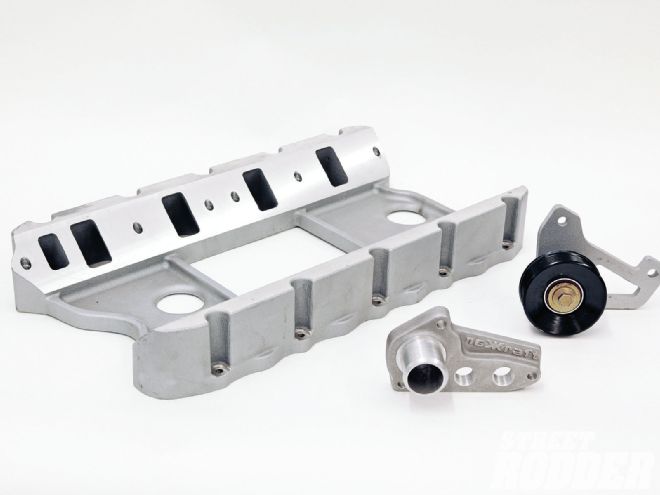
Ignition is addressed with an Edelbrock Timing Control Module (made by MSD Ignition) for the 4.6L and 5.4L Fords that locates the position of both the crank and cam and coordinates the MAP sensor, too.
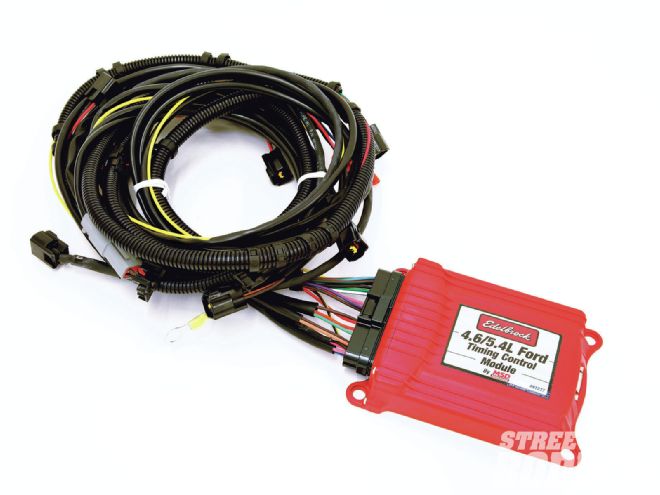
If you like the dual-quad carb setup (and who doesnt?), then Edelbrock has got you covered. Their PN 75354 intake manifold is topped with two 18014 carbs, and a 4119 air cleaner.
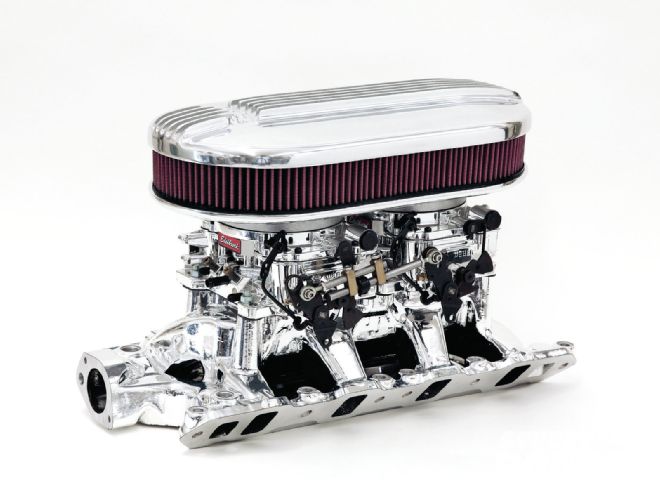
Another popular look would have to be the Inglese induction systems, which use the NG1682 intake, four NG1015 carbs, and the NG1752-8 air filters for the chrome stacks.
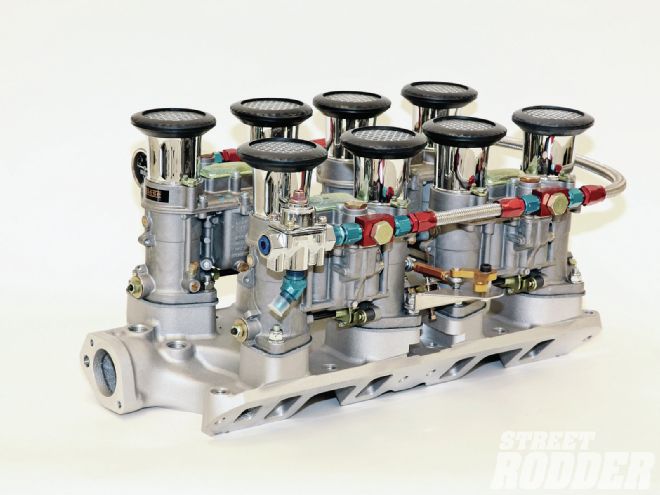
Since the alternator is moved from its factory position, the kits alternator bracket/pulley is installed where the alternator used to be (just above the water pump).
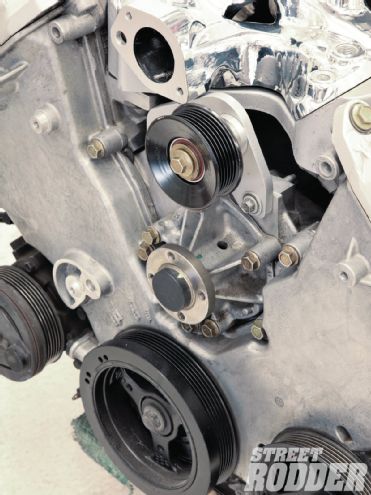
This is the stock oil filter mount location on the 4.6, but the kit comes with an adaptor that changes the position of the lower radiator hose outlet as well as allows for a remote oil filter location.
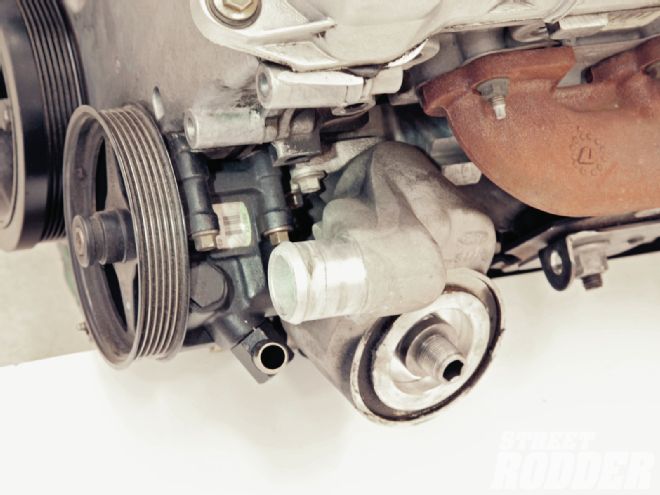
The stock 4.6 injection system, from the airbox to the injector manifold, is removed before the new manifold adaptor plate is attached.
The 32-valve 4.6 looks impressive with a full set of Inglese 48 IDAs up top, but equally as menacing with a pair of Edelbrock four-barrel carbs. A single carb setup just looks like something is missing (like another carb!).
Back in 2005, Del Packwoods 41 pickup was the first 4.6 conversion Hot Rod Haven did.
Jim Johnson (Jamies dad) has owned this 40 Ford DeLuxe since 1983. In 2011 he and Jamie installed a 4.6 and a five-speed out of an 03 Mach 1 Mustang, and reports no trouble driving it wherever he wants to go (including a recent trip to Bonneville).
A side-by-side comparison with the Inglese-equipped 4.6 on the left and a single-carb 351W Ford on the right is downright shocking! There are roughly 9 inches of overall width difference between the two powerplants.
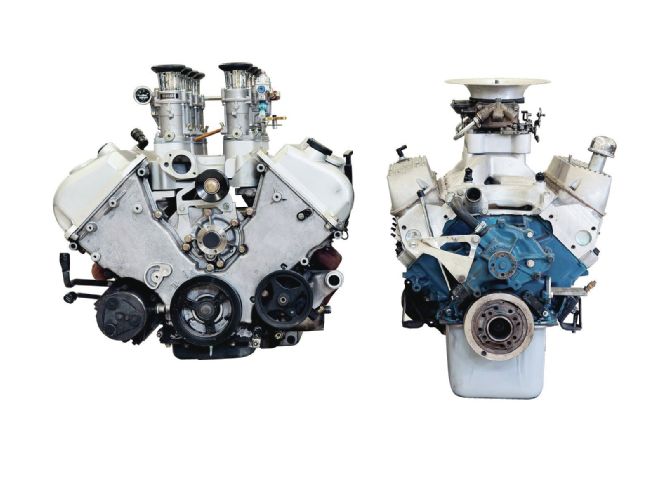
Though hot rodders like performance, there are other constraints to consider when installing an engine. Both weight and physical size are two other points to consider, so STREET RODDER decided to illustrate the physical size difference between three engines: the 4.6 Ford, the 351W Ford, and the 350 Chevrolet. For this comparison, the height is measured from the bottom of the oil pan to the air filters mounting surface. The width is measured from the outside edge of each valve cover, and the length is from the face of the bellhousing to the water pump pulley. All measurements are approximate.
The Ford 4.6 DOHC with Inglese IDAs and TREMEC five-speed transmission Width 29.25 inches Length 23.625 inches Height 31.5 inches TREMEC length: 31.375 inches Overall length with TREMEC five-speed 55 inches
The Ford 351W with Edelbrock RPM Air Gap manifold and single carb (with 2-inch spacer) and Borg-Warner five-speed transmission Width21.5 inches Length28 inches Height28 inches Borg-Warner T-5 Length31 inches Overall length with T-559 inches
The Chevrolet 350 with triple Rochesters (with 1-inch spacers) and TH350 Width22 inches Length27.75 inches Height28.5 inches TH350 Length27.5 inches Overall length with TH35055.2 inches